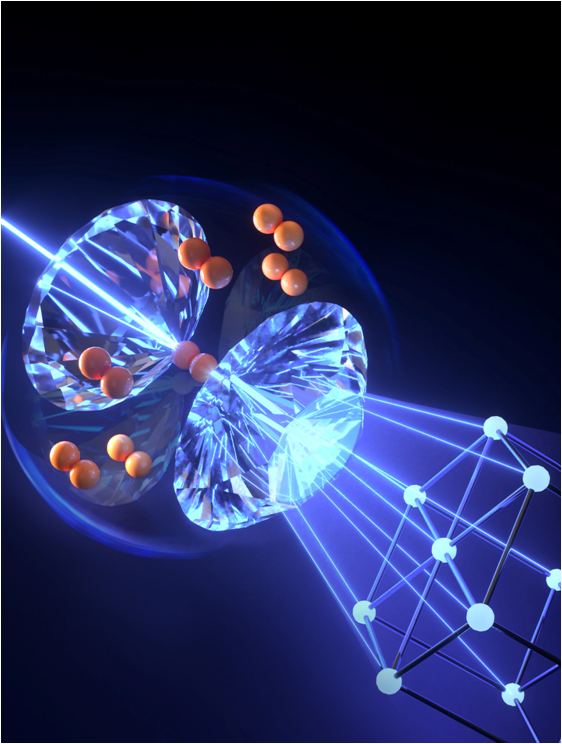Under pressure: Viewing how hydrogen transforms- Drs. Cheng Ji and Ho-Kwang Mao
SEPTEMBER 26, 2019
An international team led by HPSTAR director Dr. Ho-Kwang Mao succeeded in determining how hydrogen molecules are packed at extremely high pressures. Their work solved the long-standing mystery of what is the structure of the dense form of hydrogen, called phase IV (Roman numeral four). This work is published in Nature.
Hydrogen is the most abundant element in the Universe. Under compression, the tenuous hydrogen gas solidifies and then transforms to a number of dense, solid forms. It has been predicted that hydrogen will eventually turn into a ‘wonder’ material that contains the highest energy density, is a room temperature superconductor (conducts electricity without any resistance), flows uphill as a superfluid, and may represent a novel state of matter governed by unknown new physics. Relentless pursuit of this novel form of hydrogen over the past century has brought us close to the pressure range where this ‘wonder’ material was expected, and several new forms of hydrogen have been discovered along the way. However, the structure of hydrogen under extreme conditions is very difficult to identify, and these newly discovered hydrogen phases remained undefined.
 Using the intense x-rays from large synchrotron facilities including the Advanced Photon Source in the US and the Shanghai Synchrotron Radiation Facility in China, Mao’s team overcame the previous challenge that hydrogen is relatively invisible using x-rays, and solved the crystal structure of one of the new forms of hydrogen, called phase IV. Surprisingly, the hydrogen molecules are packed with a hexagonal symmetry, like a snow flake. The hexagonal crystals are flattened under compression, leading to the electronic transformation that forms phase IV.
Using the intense x-rays from large synchrotron facilities including the Advanced Photon Source in the US and the Shanghai Synchrotron Radiation Facility in China, Mao’s team overcame the previous challenge that hydrogen is relatively invisible using x-rays, and solved the crystal structure of one of the new forms of hydrogen, called phase IV. Surprisingly, the hydrogen molecules are packed with a hexagonal symmetry, like a snow flake. The hexagonal crystals are flattened under compression, leading to the electronic transformation that forms phase IV.
‘‘We must understand phase IV, which plays a pivotal role linking ordinary hydrogen to the exotic metallic form.’’ said Cheng Ji, the lead author of this work, ‘‘This study was very challenging. It took me five years to resolve the many technical problems, so is very exciting that we can finally solve the structure unequivocally.’’
‘‘Hydrogen under extreme condition has been one of the main focuses and grand challenges of the physics community for many decades.’’ added Ho-Kwang Mao, ‘‘At HPSTAR, we gathered experts on hydrogen, with the aim to not only discover new forms of hydrogen, but also provide reliable characterization in order to understand the novel physics of these high pressure phases. The current work is one such example which paves the road for understanding the metallization process of hydrogen.’’
The research team includes Ho-Kwang Mao, Cheng Ji, Bing Li, Jinfu Shu, Junyue Wang, and Wenge Yang of HPSTAR, Wenjun Liu, Jesse S. Smith, Guoyin Shen, Yue Meng, Ruqing Xu, and Xianrong Huang of Advanced Photon Source, Argonne National Laboratory, Vitali B. Prakapenka and Eran Greenberg of University of Chicago, Stanislav Sinogeikin of DACTOOL. Inc, Arnab Majumdar, Wei Luo, and Rajeev Ahuja of Uppsala University, and Wendy L. Mao of Stanford University.
Caption: The strong synchrotron X-ray beam shoots on solid hydrogen squeezed in between two diamonds, showing the crystal structure (the pattern of how molecules are arranged in the atomic level) of hydrogen at millions of atmosphere pressure.
氢的金属化问题一直是高压科学的焦点和热点,但是研究者及关注者往往仅注重金属氢是否被发现,而在一定程度上忽略了对金属氢进行准确表征的重要性。近日,由北京高压科学研究中心(简称高科)的毛河光院士领导的科研小组,与国外科研院校的科学家通力合作,通过超高压技术以及同步辐射X射线衍射相关技术的自主研发,采用金刚石对顶砧技术首次在两百二十万个大气压以上实现了对固态氢第IV相的晶体结构精确测量。破解了长期困扰高压氢研究中最基本最亟需解决的技术难题,将此前法国科学家在此类实验上保持的压力记录提高了一倍,为今后直接测量超高压下固态氢以至金属氢的晶体结构提供一个切实可行的技术手段。相关成果发表于国际顶级学术期刊《自然》上。
